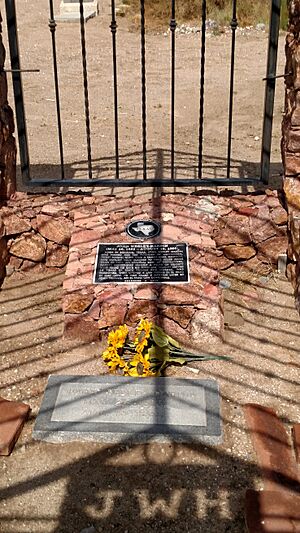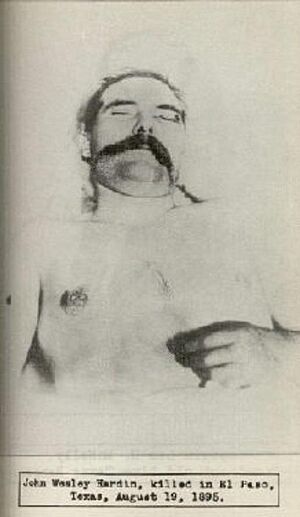John Wesley Hardin facts for kids
Quick facts for kids
John Wesley Hardin
|
|
|---|---|

This ferrotype photograph is a mirror image of Hardin.
|
|
| Born | May 26, 1853 Whitewright, Texas, U.S.
|
| Died | August 19, 1895 (aged 42) El Paso, Texas, U.S.
|
| Cause of death | Gunshot wound |
| Other names |
|
| Occupation | gambling/card sharp, cowboy, cattle rustler, lawyer |
| Known for | very young outlaw and prolific gunfighter |
| Spouse(s) |
|
| Parent(s) | James Gibson "Gip" Hardin Mary Elizabeth Dixson |
John Wesley Hardin (born May 26, 1853 – died August 19, 1895) was a famous figure from the Old West. He was known as an outlaw and a skilled gunfighter. Hardin often found himself in trouble with the law from a young age. He claimed he killed his first person at 15, saying it was to defend himself.
Law enforcement officers chased Hardin for most of his life. In 1877, when he was 23, he was sent to prison for 24 years for a killing. At that time, Hardin claimed he had killed many people. While in prison, he studied law and started writing a book about his life. He was known for making his stories sound bigger or even making them up.
Hardin was released from prison in 1894. Less than a year later, he was killed by a man named John Selman in a saloon in El Paso.
Contents
Early Life of John Wesley Hardin
John Wesley Hardin was born in 1853 near Bonham, Texas. His father, James Gibson "Gip" Hardin, was a Methodist preacher who traveled a lot. His mother was Mary Elizabeth Dixson. John was named after John Wesley, who started the Methodist church.
Hardin wrote in his autobiography that his mother was kind and educated. His father moved the family to Sumpter, Texas, in 1859. There, his father started a school where John and his brothers and sisters learned. John was the second oldest of ten children. His family was important in the Southern states.
When the Civil War began, Hardin's father became a captain for the Confederate army. In 1862, when John was just nine years old, he tried to run away from home to join the Confederate army.
Life as a Fugitive
At age 15, Hardin was involved in his first killing. He said it was to protect himself. After this, he often got into trouble, including fights. Hardin became a well-known gunfighter and outlaw.
He worked as a cowboy, moving cattle to Kansas. During this time, he was involved in more gunfights. Hardin spent years trying to escape from law enforcement. He even went to Florida and used different names to hide.
Even though he was an outlaw, Hardin married Jane Bowen in 1872. They had three children together.
Captured by Texas Rangers
On January 20, 1875, the Texas government offered a $4,000 reward for Hardin's capture. A Texas Ranger named Jack Duncan found a letter that helped them track Hardin. The letter said Hardin was hiding near the Alabama-Florida border, using a different name.
In 1876, Hardin was involved in a fight in Florida where someone was hurt. In 1877, Texas Rangers and local police found Hardin on a train in Pensacola, Florida. He tried to pull out his pistol, but it got stuck. The officers were able to capture him.
Trial and Time in Prison
Hardin was put on trial. On June 5, 1878, he was sentenced to 25 years in Huntsville Prison. He tried to escape from prison several times. In 1879, he and 50 other prisoners were stopped just before they could tunnel into the prison's weapon storage area.
Hardin eventually got used to prison life. He read religious books and became the leader of the prison's Sunday School. He also studied law. He often had poor health, especially from an old wound that became infected in 1883. This made him sick for almost two years. In 1892, Hardin was described as about 5 feet 9 inches tall and weighing 160 pounds. He had light skin, hazel eyes, and dark hair. He also had scars from old wounds on different parts of his body. On November 6, 1892, while Hardin was in prison, his first wife, Jane, passed away.
While in prison, he wrote a book about his life. He was known for making up or greatly exaggerating stories about what he had done.
After Prison
On February 17, 1894, Hardin was released from prison. He had served seventeen years of his 25-year sentence. He was 40 years old when he returned to Gonzales, Texas. Later that year, on March 16, he received a pardon, which meant his sentence was officially forgiven. On July 21, he passed the state's law exam and became a licensed lawyer.
According to a newspaper article from 1900, shortly after leaving prison, Hardin was involved in a tragic accident. He made a bet that he could shoot near a man sitting on a box. The man fell and died from the fall.
On January 9, 1895, Hardin married a 15-year-old girl named Callie Lewis. This marriage ended quickly, though it was never officially ended by law. After this, Hardin moved to El Paso, Texas.
Death
In El Paso, a lawman named John Selman Jr. arrested a woman Hardin knew. Hardin argued with Selman Jr. Later that day, on August 19, 1895, Selman Jr.'s father, Constable John Selman Sr., who was also a well-known gunman, spoke angrily with Hardin.
That night, Hardin went to the Acme Saloon and started playing dice. His last words were "Four Sixes to Beat." Shortly before midnight, Selman Sr. walked into the saloon, came up behind Hardin, and shot him. Hardin was killed. He was buried the next day in Concordia Cemetery in El Paso.
Legacy
The many events in Hardin's life, some real and some exaggerated, made him a legend of the Old West. He became a famous figure in American stories. His autobiography was published after his death in 1925.
Firearms and Personal Items
Hardin's favorite weapons and some of his personal items have been carefully recorded and sold to collectors. Court records show that Hardin had a Colt "Lightning" revolver when he died. He also carried an Elgin watch. These items were given to Hardin because he helped a man named Jim Miller with legal issues. The Colt revolver was nickel-plated with special grips and an engraving. This gun and its holster were once sold for $168,000 at an auction. Another Colt revolver that Hardin owned was sold at the same auction for $100,000.
In 2002, an auction house sold three groups of John Wesley Hardin's personal items. One group, which included his playing cards, business cards, and a newspaper story about his death, sold for $15,250. The bullet that killed Hardin was sold for $80,000.
See also
 In Spanish: John Wesley Hardin para niños
In Spanish: John Wesley Hardin para niños




